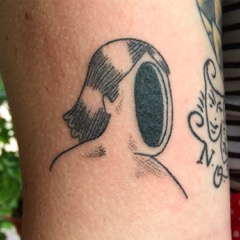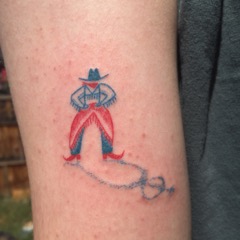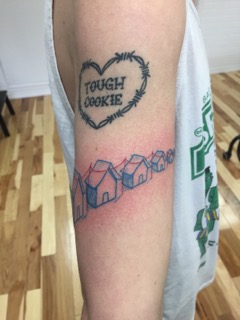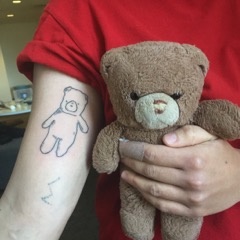Em Jiang
Name: Em Jiang
Current City: Providence, RI
Hometown: Reno, NV
Occupation: Student
Em Jiang grew up in Reno, Nevada with aspirations of moving as far away as possible only to realize how much she would miss everything once it was gone.
"Being a first generation Chinese American, I am always battling and trying to come to terms with my diaspora and displacement, always trying to unlearn the resentment I internalized for my 'home'," starts Jiang. "I struggled a lot with accepting my home, for both Reno and China, but now both places are inseparable from my identity, and that's something I continually return to."
Now, Jiang is studying filmmaking at Rhode Island School of Design (RISD), where she can confidently engage with art as a career.
"My relationship with art has really helped ground me and allowed me to feel okay being alone with myself, which has mobilized me and motivated me to explore different environments, spaces and communities," begins Jiang. "Everything I do is a reflection of my process – it's about genuine interactions, observation and sensitivity to the colors, feelings, people, sounds, history and where I am in all of it. That's why I carry my sketchbook around with me everywhere, there's always something to draw about, as long as I'm anywhere at all."
Read on to discover more of Jiang’s journey through art and life!
What attracted you to the world of hand-poked tattoos, and why did you choose hand-poked over using a tattoo machine?
I remember the first tattoo I gave myself, alone in my bedroom - with India ink, a sewing needle, thread, and a #2 pencil. I was always scared of needles but something about tattooing didn’t really freak me out. I ultimately did it to explore the relationship I could have with my body. I have struggled with body image issues all my life, but somehow, tattooing myself made me feel a little more confident and gave me ownership over my body in a way that I didn't have before. Even if I didn’t feel good about other parts of my body, I could pull down my sock and show everyone the little triangle poked permanently on my ankle, and feel a little proud of that piece of me that I chose to keep forever.
Because of that, I've always had a special relationship with hand poking. Machine tattooing loses a lot of intimacy, which is one reason it never appealed to me as much. I trusted myself with a needle. I have the biggest fear of messing someone’s body up forever. Of course, I made some mistakes when I was first starting, but with handpoking I could be very careful, and I loved the process of teaching myself the skin’s limits and figuring out what and what doesn’t work.
At the time I started tattooing, I didn’t have my own place, so I had all my tattoo supplies in a kit that I would take with me to people’s homes, and set up in their living rooms. I loved this ritual so much, and I loved that handpoking allowed me to engage with and connect with people in such an intimate way in such an intimate space. I thought back to when I got my first shop tattoo at 18, and how sterile, masculine, and insignificant that experience felt to me. That’s when I really began to bond with my practice of handpoking in a way that was in direct retaliation to toxic tattoo shop culture, one that didn’t have space for QTPOC people like me.
I think handpoked tattoos can be more meditative and reflective than a machine tattoo~ I’ve had quite a few people actually snooze off during a session! I think there’s also a lot of trust that goes into the exchange as well since handpoking is much more meticulous and time-consuming than machine tattoos. Both my client and I know that we have to spend quite a bit of time together, and it's important to curate a space where we are both comfortable. I think my experience as a “traveling home tattoo artist” has really humbled my practice. Not only are a bunch of people walking around with my art on them forever, but I also can look at each of them and remember the space, ambiance, and feeling of the place I gave them the tattoo in. It has really helped me recognize and prioritize the individual experience of all the people who come to get tattooed by me.
Do you have any interest/experience with a tattoo machine?
I’ve only used a tattoo machine once, and let me tell you~ it was SO Fun, and SO FAST! However, at the moment I am not interested in learning machine.
I just started handpoking a couple years ago! I have so much to learn. I do not think that machine is an upgrade from handpoking- it is just the Western/white standard for tattooing. I think handpoking is just as valid of a technique as machine tattooing is.
Machine tattooers are never asked if they have considered doing hand poked tattoos. Handpoking shouldn't be looked down upon for being accessible for anyone to try, it should be praised for its DIY history and the culture surrounding that. Hand poked tattoos are also much gentler on the skin, which can be a better method for POC/people with sensitive skin that scar easily from the trauma of machine tattoos.
I love how accessible handpoking is, and I love teaching myself new tricks and learning tips from other DIY hand pokers I meet on my travels. I really feel like I have ownership over my handpoking practice because I am completely self-taught and have earned every bit of trust my clients give me when they come to get a tattoo from me. I developed all my methods and style myself, and I’m proud of that. Handpoked tattoos for the people!
Where do the inspirations for your tattoos arise from? Are they custom designs you put out into the world or do clients come to you with ideas as well?
I only tattoo designs I have already drawn up~ only rarely do I do commission work. Everywhere I go I am always drawing in my sketchbook, and I really mean everywhere I go. I’ll usually go through my sketchbook, pull out or rework ideas and designs that I like and draw them out on a flash page that people can select from. They can also choose directly from my sketchbook. Once a client gets a design, it's theirs forever. I don’t repeat designs. For my tattoo designs, I like playing with surreal imagery (usually with figures) and nostalgic objects or symbols (such as houses, which I seem to always be drawing).
It’s important to me that I have ownership over my process, and that tattooing is always something that I’m excited to do. This is why I don’t usually take commissions/other designs. I’ve found that sometimes with commissions, clients will lose sight of me as an artist and see me as a service instead. If a client comes to me and asks me to design a flamingo tattoo for them, I’d decline, because if they had looked at my previous work, they would see that I am not interested in that subject. However, if a client comes to me and asks me to draw something similar to a design I’ve already done because it reminded them of an experience they had that was significant to them, I would probably take on the project, because there is content there that we have both connected on, and an appreciation and understanding of each other that I can work with.
Outside of tattooing, you're an illustrator and animator. How would you describe your style of art?
I like to play with a lot of surreal imagery, repetition, and color. I like playing with characters and figures (most of the characters I create and draw usually don’t have genders either). I’d like to think my art reflects a truth in my reality in a slightly satirical way and portrays the world as absurd or fantastical and relatable.
I saw your stop-motion short, Land Lord and it's phenomenal. Will you walk us through the steps of creating a stop-motion film? What are the challenges?
Animation is just a magic trick you play on your eyes. You’re not watching a moving image, you’re watching pictures that are flashing at 24 frames/second and your brain convinces you that it’s moving. This means that when you create an animation, you have to do it one frame at a time, bit by bit, till it creates a movement- just like with handpoking, I’ll poke one dot at a time until it creates a line, until it creates an image.
Most of animation exists on a flat surface- inside a computer, on a sheet of paper. For stop motion, you have to create a 3D environment that actually exists. If you want your character to sit down on a couch in the living room, you have to make the mini couch, make the mini character, make the carpet, the walls, the tiny houseplant in the corner, and the tiny picture frame with a tiny family portrait in it. When you shoot the scene, you shoot one frame at a time, moving your character one tiny bit each time. Snap a picture. Move the leg a tiny bit. Snap another picture. And be sure not to move any of the other tiny props with your massive fingers when you’re moving the character, or else you might have to scrap everything and reshoot the scene. It’s a horrible, tedious, antagonizing process…..but I love it.
Do you have any projects on the books you'd like the readers to know about?
After a busy semester and lots of traveling for tattoo guest spots, I injured my hands from all the repetitive strain. Since then, I’ve been trying to take it easy to recover, so I have been on a hiatus from tattooing. It has been tough stopping after gaining so much momentum- but I know I need to take care of my health if I want to keep doing art for a long time. Lately, I’ve been trying to focus on music and poetry. I have been playing around on my banjo, synthesizer, guitar, and violin, and I’ve performed at a couple of small shows. I’m hoping to bond more with this medium and use this hiatus to really get comfortable with creating music the same way I create visual art.
How does creating art help you find peace in life?
Art has continually helped me recon and appreciate my individuality- and that sounds really corny but it’s true. My relationship with art helps me validate my reality, recognize my unique perspective and the way I process things. Yet, my art exists in a collective. Because of social media, it’s so amazing when people resonate with my art because it shows me that I’m not so alone in my reality, in my fears, in my anxieties, in the way I perceive myself and my environment.
Describe your dream life.
Yes, there are things that I want but don’t have yet, there are things that make my life difficult and impossible sometimes, and I might not be where I want to be just yet. But I still think I am living my dream life. Overall, I feel an extreme gratitude for how far I’ve gotten, how much I’ve learned, and how much farther I have left to go. I used to think that once I get to a certain point, I’ll be happier and my life will be better, but every time I’ve gotten closer to what I thought I wanted, it has been accompanied by the same struggles and sadness that I’ve always had before, but just in different contexts. I’ve learned that you can’t expect or plan a future for yourself that is without hardship- as things get better, they also get more complicated and difficult too.
My determination and confidence in my skills and self give me the confidence to see that nothing is out of my reach. I’m growing, learning, creating, and among other things, that’s the most I can ask out of my life.
Discuss the importance of paying it forward?
Paying it forward recognizes your own capacity to influence people in a positive way, and is radical in itself within this capitalist society where possession and gain are almost more important than being good and decent to each other. Oh and remember to tip service workers and artists!
If you could give one piece of advice to young individuals around the globe, what would it be and why?
Don’t get comfortable with stagnancy. I truly believe movement and travel are one of the most healing and humbling things- and I don’t mean tourism stuff.
I think genuine travel is about a dedication not to a destination, but to being in a place, moving around a place and a consciousness of yourself as a part the environment. My first time hitchhiking really changed my perspective and relationship to movement, challenging my ability to trust my environment to take me where I need to go. You don’t have to go to that extreme, you could just hop on a local bus and ride to a neighborhood you’ve never been before. It’s so easy to get wrapped up in your own little world, but I’ve found that every time I travel, I start to feel a bit smaller again, and I can take a step back and remember to focus on existing and observing rather than the issues of my ego.
Who are some of your greatest influences?
My biggest influencers are the people who are a part of the Holland Project, which is a DIY nonprofit art and music venue in my hometown, Reno. I truly do not think I would be the artist I am today without that organization. The first gallery I showed art in was the Holland Project, as well as the first place I performed with my band. The wonderful community of artists, musicians, and organizers who make the Holland Project possible are the first people who validated me as an artist, and made me realize my future in art. After moving away, I realized, there really is nothing like it, and I’m always searching for and trying to create spaces as nurturing and safe as that one.
What does empowerment mean to you?
For me, empowerment aims to counteract the oppression inflicted upon a culture or group of people in regards to an aspect of their identity or existence. Empowerment is recognizing and locating the source of oppression, (which for me is usually the white, Western patriarchy) and reclaiming what they took. However, it has to be from the oppressed themselves, which is why tokenizing is not a form of empowerment, it is just a way for white people to capitalize on marginalized groups, and furthers the oppression. I also think marginalized people sometimes internalize a lot of oppression, I know I did for sure, so empowerment can also be unlearning those prejudices and learning to respect and love yourself in a society that has made you believe parts of your identity are lesser or wrong.
Follow Em’s handpoked journey on Instagram and view her sketches, animations/videos and miscellaneous projects!









